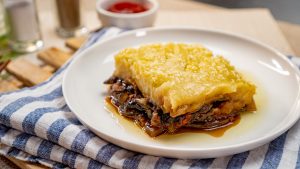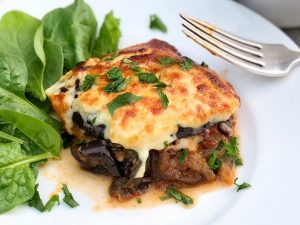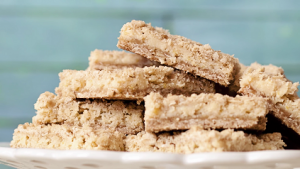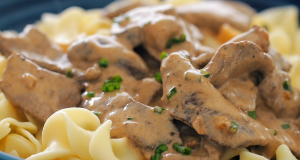Moussaka is a traditional Greek casserole dish with layers of eggplant, zucchini, flavorful meat mixture, and a creamy béchamel sauce. This classic moussaka recipe brings together all these elements to offer a comforting and hearty meal that is ideal for a family dinner or a social gathering.
Most of the ingredients in this recipe are common and easy to find. However, one ingredient that might not be readily available is kasseri cheese, a sharp sheep's milk cheese popular in Greek cuisine. If you can't find kasseri cheese in your local supermarket, you can substitute it with another sharp cheese like Pecorino Romano.
Key Ingredients for Classic Moussaka
Eggplants: These are the base of the moussaka. Choose firm, dark purple eggplants.
Zucchini: This adds a different texture and flavor to the dish.
Olive oil: Used for frying vegetables and sautéing ingredients.
Kasseri cheese: A Greek cheese that adds a savory flavor to the dish.
Ground meat: This could be beef, veal, or lamb.
Onion: Adds sweetness when sautéed
Garlic: Provides a robust flavor.
Cinnamon, Nutmeg, and Clove: These spices lift the flavor of the ground meat.
Tomato paste: Concentrates the sauce and gives it body.
Butter: Used in the béchamel sauce.
Flour: Thickens the béchamel sauce.
Milk: The main liquid for the béchamel sauce.
Eggs: They help bind the béchamel sauce and give it a rich taste.
One reader, Carine Needham says:





The classic moussaka recipe is a delight! The layers of eggplant, zucchini, and flavorful meat, topped with a rich and creamy béchamel sauce, create a heavenly combination of flavors. It's a comforting and satisfying dish that's perfect for a cozy family dinner. Highly recommended!
Techniques Required for Making Classic Moussaka
How to fry the vegetables: Fry the seasoned eggplants and zucchini in olive oil until they are brown on both sides, then blot the excess oil with paper towels.
How to make the meat sauce: Brown the meat in a warm sauté pan, then remove it. In the same pan, sauté onions, garlic, and spices until softened. Add the browned meat and tomato paste, then cook until all the water has evaporated. Allow the mixture to cool completely.
How to make the béchamel sauce: Melt butter in a saucepot, then add flour and cook until it achieves a blond color. Gradually whisk in the milk and simmer for 45 minutes, stirring continuously to prevent burning. Season the sauce with spices, salt, and pepper. Once it reaches a thick consistency, remove it from the heat and rapidly whisk in the eggs. Allow the béchamel to cool before using.
How to assemble the moussaka: Layer the zucchini and eggplant in an oven-proof casserole dish, followed by the cooled meat mixture. Top with the cooled béchamel and a generous amount of grated cheese. Refrigerate for 15 minutes to set, then bake at 375°F for 15 minutes. Remove the foil, increase the oven temperature to 450°F (or broil), and brown the top of the moussaka. Let it cool for 10 minutes before serving.
How To Make Moussaka
This eggplant lasagna or moussaka recipe is layered with broiled eggplant, flavorful ground lamb sauce, and creamy cheese for a filling Mediterranean dish.
Serves:
Ingredients
- 6tbspcooking oil
- 1onion
- 2clovesgarlic
- 1lbground lamb
- ½cupred wine
- 1tbsptomato paste
- 1½cupscrushed tomatoes in thick puree,(15 oz) canned
- 1bay leaf
- 1cinnamon stick
- 1tspground allspice
- 1tspsalt
- fresh ground black pepper
- 1lbeggplant
- 4ozcream cheese
- ¼cupmilk
- ¼cupparmesan,grated
Instructions
-
Heat the broiler. In a large stainless-steel frying pan, heat 1 tablespoon of the oil over moderate heat. Add the onion and garlic; cook for about 3 minutes until starting to soften.
-
Add the lamb and cook for about 2 minutes until the meat loses its pink color. Stir in the wine, tomato paste, tomatoes, bay leaf, cinnamon, allspice, ¾ teaspoon salt, and ¼ teaspoon pepper. Bring to a boil and reduce heat. Simmer, covered for 10 minutes.
-
Brush both sides of the eggplant slices with the remaining oil and season with ⅛ teaspoon each salt and pepper.
-
Put the eggplant slices on a large baking sheet and broil, 6-inches from the heat, for about 5 minutes until browned. Turn and broil for about 5 minutes longer until browned on the other side.
-
In a small saucepan, combine the cream cheese, milk, ⅛ teaspoon salt, and a pinch of pepper. Warm over low heat until just melted.
-
Oil an 8×8-inch baking dish. Layer half the eggplant in the dish, then half the meat sauce. Sprinkle with half the Parmesan. Repeat with the remaining eggplant, meat sauce, and Parmesan.
-
Spoon the cream-cheese sauce on top; broil until just starting to brown, 1 to 2 minutes.
-
Serve and enjoy.
Nutrition
- Calories: 755.30kcal
- Fat: 60.77g
- Saturated Fat: 20.51g
- Trans Fat: 0.08g
- Monounsaturated Fat: 27.52g
- Polyunsaturated Fat: 8.73g
- Carbohydrates: 22.27g
- Fiber: 6.69g
- Sugar: 11.78g
- Protein: 27.70g
- Cholesterol: 121.81mg
- Sodium: 1070.29mg
- Calcium: 245.33mg
- Potassium: 1001.69mg
- Iron: 4.02mg
- Vitamin A: 145.23µg
- Vitamin C: 14.78mg
Technique Tip for Perfecting Your Moussaka
When frying your eggplants and zucchini, make sure the oil is hot enough before adding the vegetables. This will ensure they get a nice, crispy exterior without becoming too greasy. Also, when making the béchamel sauce, it's important to whisk the eggs in rapidly off the heat to prevent them from scrambling. Lastly, allowing the moussaka to cool for a few minutes before serving will make it easier to cut into neat slices.
Time-Saving Tips for Preparing Moussaka
Prep ahead: Chop and fry the eggplants and zucchinis a day in advance. Store them in the refrigerator until ready to assemble the moussaka.
Multi-task: While the béchamel sauce is simmering, you can work on other components of the dish to save time.
Organize ingredients: Measure and prepare all the ingredients before starting the cooking process to streamline the cooking process.
Use pre-shredded cheese: Save time by using pre-shredded cheese instead of grating it yourself.
Bake in advance: Prepare the moussaka a day ahead and refrigerate. Bake it when ready to serve for a time-saving meal.
Substitute Ingredients For Moussaka Recipe
eggplants - Substitute with zucchini: Zucchini can be used as a substitute for eggplant in moussaka to provide a similar texture and mild flavor.
kasseri cheese - Substitute with pecorino cheese: Pecorino cheese has a similar sharpness and saltiness to kasseri cheese, making it a suitable substitute in moussaka.
ground beef - Substitute with ground lamb: Ground lamb can be used as a substitute for ground beef to add a rich and savory flavor to the moussaka.
milk - Substitute with unsweetened almond milk: Unsweetened almond milk can be used as a dairy-free substitute for milk in the bechamel sauce without compromising the creamy texture.
butter - Substitute with olive oil: Olive oil can be used as a healthier substitute for butter in the bechamel sauce, providing a similar richness and flavor.
clove - Substitute with allspice: Allspice can be used as a substitute for clove to add a warm and aromatic flavor to the moussaka.
cinnamon - Substitute with nutmeg: Nutmeg can be used as a substitute for cinnamon to add a warm and slightly sweet flavor to the dish.
Presenting Your Moussaka Dish
Elevate the layers: Carefully layer the fried eggplants and zucchinis in a precise and visually appealing manner, ensuring each layer is evenly distributed and perfectly aligned.
Garnish with fresh herbs: Sprinkle a delicate arrangement of freshly picked parsley and oregano over the top of the moussaka to add a pop of vibrant color and a touch of earthy freshness.
Incorporate edible flowers: Introduce a few edible flowers, such as vibrant nasturtiums or delicate pansies, to add a touch of elegance and a subtle floral note to the dish.
Create a drizzle design: Using a small squeeze bottle, carefully drizzle a light, artistic design of olive oil over the top of the moussaka, adding a glossy finish and a hint of richness.
Accent with microgreens: Sprinkle a handful of microgreens, such as baby arugula or radish sprouts, around the edges of the plate to provide a delicate and visually appealing accent to the dish.
Utilize elegant serving ware: Present the moussaka on a sophisticated, minimalist plate or dish, allowing the vibrant colors and textures of the dish to take center stage.
Add a touch of gold leaf: For an extra touch of luxury, delicately place a few edible gold leaf flakes on top of the moussaka, adding a subtle shimmer and a touch of opulence to the presentation.
Emphasize symmetry: Ensure that the moussaka is presented with a focus on symmetry, creating a visually balanced and harmonious display that showcases the layers and textures of the dish.
Essential Tools for Making Moussaka
- Cutting board: A flat surface used for cutting and preparing ingredients.
- Chef's knife: A versatile knife used for chopping, slicing, and dicing ingredients.
- Baking dish: A rectangular or square dish used for baking the moussaka in the oven.
- Sauté pan: A wide, flat-bottomed pan used for sautéing the meat and making the sauce.
- Saucepot: A deep cooking pot used for making the béchamel sauce.
- Whisk: A kitchen utensil used for blending and mixing ingredients, essential for making the béchamel sauce.
- Oven-proof casserole: A heat-resistant dish suitable for baking in the oven.
- Aluminum foil: Used for covering the moussaka while baking to ensure even cooking.
- Grater: Used for grating the cheese for the moussaka.
- Paper towel: Used for blotting excess oil from the fried eggplant and zucchini.
Storing and Freezing Moussaka for Later
- Allow the moussaka to cool completely before storing or freezing. This will take about 1-2 hours at room temperature.
- To store in the refrigerator, cover the baking dish tightly with plastic wrap or aluminum foil. The moussaka will keep well in the fridge for up to 3-4 days.
- To freeze, cut the moussaka into individual portions and place them in airtight containers or freezer bags. Label the containers with the date and contents.
- Alternatively, you can freeze the entire baking dish. Wrap it tightly with plastic wrap and then aluminum foil to prevent freezer burn. The moussaka will keep well in the freezer for up to 2-3 months.
- To reheat from the refrigerator, place the desired portion in a microwave-safe dish and heat until warmed through, about 2-3 minutes. You can also reheat it in a 350°F (175°C) oven for about 20-30 minutes, or until heated through.
- To reheat from frozen, thaw the moussaka in the refrigerator overnight. Then, reheat it in a 350°F (175°C) oven for about 30-40 minutes, or until heated through and the cheese is melted and bubbly.
- If reheating the entire frozen baking dish, remove the plastic wrap and cover the dish with aluminum foil. Bake in a 350°F (175°C) oven for about 1 hour, or until heated through and the cheese is melted and bubbly.
- Note: The béchamel sauce may separate slightly when reheated, but it will still taste delicious. Give the moussaka a good stir before serving to redistribute the sauce.
How To Reheat Moussaka Leftovers
Preheat your oven to 350°F (175°C). Place the leftover moussaka in an oven-safe dish and cover it with aluminum foil. This will help prevent the top layer from drying out or burning while the inside heats through. Bake for about 30-40 minutes, or until the moussaka is heated through and the cheese is melted and bubbly.
If you prefer a crispier top layer, remove the foil for the last 5-10 minutes of reheating. This will allow the béchamel sauce and cheese to brown slightly, giving you a deliciously crunchy texture that contrasts nicely with the soft eggplant and zucchini layers beneath.
For a quicker reheating method, you can use the microwave. Place a single serving of moussaka on a microwave-safe plate and heat it on high power for 1-2 minutes, or until it's heated through. Be aware that microwaving may cause the béchamel sauce to separate slightly, but it will still taste delicious.
If you have a large portion of leftover moussaka, you can reheat it in a covered skillet on the stovetop over medium-low heat. Stir occasionally to ensure even heating and to prevent the bottom from scorching. This method may take a bit longer, but it's a good option if you don't want to use the oven or microwave.
For a crispy bottom layer, place the leftover moussaka in a preheated air fryer basket and cook at 350°F (175°C) for 5-7 minutes, or until heated through and the top is golden brown. This method works best for smaller portions and will give you a delightfully crunchy exterior while keeping the interior soft and flavorful.
Random Fact About Moussaka
Moussaka is a traditional dish in Greek cuisine and is often considered the country's national dish. It is a rich and flavorful casserole made with layers of eggplant, zucchini, and a savory meat sauce, topped with a creamy béchamel sauce. This dish is a staple in Greek households and is often served at special occasions and family gatherings. It is a versatile dish that can be made with different variations of meat and vegetables, making it a popular and beloved recipe in Greek culture.
Is Making Moussaka at Home Economical?
This classic moussaka recipe offers a moderate cost-effectiveness for a household. The combination of eggplants, zucchini, and ground meat makes it a hearty and filling dish. However, the use of kasseri cheese and butter may slightly elevate the cost. The rich flavors and satisfying nature of this dish make it worth the investment. On a scale of 1-10, it rates a solid 8 for its taste and versatility. The approximate cost for a household of 4 people is around $25-$30, making it a reasonable option for a special family meal.
Is Moussaka Healthy or Unhealthy?
The classic moussaka recipe, while undeniably delicious, is not particularly healthy due to several factors:
- The eggplants and zucchini are fried in olive oil, which adds significant calories and fat to the dish
- The recipe calls for a large amount of cheese, which is high in saturated fat and calories
- The béchamel sauce is made with butter, flour, and whole milk, contributing to the dish's high calorie and fat content
- The meat mixture, especially if using ground beef or lamb, can be high in saturated fat
However, the recipe does include some nutritious ingredients, such as eggplants, zucchini, onions, and garlic, which provide fiber, vitamins, and minerals.
To make this recipe healthier, consider the following modifications:
- Grill or roast the eggplants and zucchini instead of frying them to reduce the oil content
- Use a reduced-fat cheese or a smaller amount of the sharp sheep's milk cheese
- Opt for lean ground turkey or chicken instead of beef, veal, or lamb
- Prepare the béchamel sauce using low-fat milk and a reduced amount of butter
- Increase the proportion of vegetables in the dish, such as adding sliced tomatoes or red bell peppers
- Serve the moussaka with a side salad to boost the overall nutrient content of the meal
Editor's Thoughts on This Classic Greek Dish
The classic moussaka recipe you've provided is a delightful combination of flavors and textures. The layers of fried eggplant and zucchini, savory meat mixture, and rich béchamel sauce create a harmonious blend of tastes. The use of aromatic spices like cinnamon, nutmeg, and clove adds depth to the dish, while the kasseri cheese provides a deliciously gooey topping. The detailed instructions ensure a successful outcome, and the final touch of browning the top adds a beautiful finish. This recipe is a wonderful representation of traditional Greek cuisine and is sure to impress anyone who tries it.
Enhance Your Moussaka Recipe with These Unique Side Dishes:
Similar Dishes to Classic Moussaka
Appetizers and Desserts to Serve With Your Moussaka
Why trust this Moussaka Recipe:
This recipe is a classic moussaka that has been perfected over generations, ensuring its authenticity and deliciousness. The use of fresh eggplants and zucchini guarantees a flavorful and wholesome dish. The incorporation of kasseri cheese adds a rich and tangy element, elevating the overall taste. The carefully crafted béchamel sauce brings a creamy and indulgent texture, complementing the layers of meat and vegetables. With a harmonious blend of spices and a meticulous assembly process, this recipe promises a delightful dining experience that captures the essence of traditional Mediterranean cuisine.
Was this page helpful?
Have your own special recipe to share? Submit Your Recipe Today!















